Work-Energy Theorem for a Variable Force | Physics for ACT PDF Download
Work Energy Theorem
If the resultant or net force acting on a body is Fnet then Newton's second law states that
Fnet = ma ...(1)
If the resultant force varies with x, the acceleration and speed also depend on x.
Work done by net force Fnet in displacing a particle equals to the change in kinetic energy of the particle.
i.e. we can write eq. (3) in following way
(W.D)C + (W.D)N.C + (W.D)ext. + (W. D)pseudo
= ΔK ...(4)
where (W.D)C = work done by conservative force
(W. D)N.C = work done by non conservative force.
(W.D)ext = work done by external force
(W.D)pseudo = work done by pseudo force, we know that
we know that
(W.D)c = - ΔU
⇒ - ΔU + (W.D)N.C + (W.D)ext (W.D)pseudo = ΔK
= (W.D)N.C + (W.D)ext + (W.D)pseudo - (kf + uf) - (ki + ui)
∴ k 4+ u = Mechanical energy.
=> work done by forces (except conservative forces) = change is mechanical energy.
If (W.D)N.C = (W.D)ext = (W.D)pseudo = 0
= Kf + Uf = Ki + Ui
Initial mechanical energy = final mechanical energy
This is called mechanical energy conservation law.
Questions Based on work Energy Theorem :
(A) When only one conservative force is actingEx.14 The block shown in figure is released from rest. Find out the speed of the block when the spring is compressed by 1 m.

Sol.
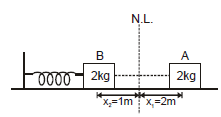
In the above problem only one conservative force (spring force) is working on the block so from mechanical energy conservation
at A block is at rest so ki = 0
At position B if speed of the block is v then
Putting the above values in equation (i), we get
Ex.15 A block of mass m is dropped from height h above the ground. Find out the speed of the block when it reaches the ground.
Sol.
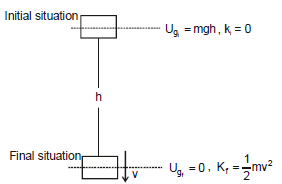
Figure shows the complete description of the problem only one conservative force is working on the block. So from mechanical energy conservation
kf + uf = ki + ui


(B) When two conservative force are acting in problem.
Ex.16 One end of a light spring of natural length d and spring constant k is fixed on a rigid wall and the other is attached to a smooth ring of mass m which can slide without friction on a vertical rod fixed at a distance d from the wall. Initially the spring makes an angle of 37º with the horizontal as shown in fig. When the system is released from rest, find the speed of the ring when the spring becomes horizontal. [sin 37º = 3/5]
Sol. If l is the stretched length of the spring, then from figure
Now, taking point B as reference level and applying law of conservation of mechanical energy between A and B,
EA = EB
or
[as for, B, h = 0 and y = 0]
or Ans.
Ex.17 The block shown in figure is released from rest and initially the spring is at its natural length. Write down the energy conservation equation. When the spring is compressed by l1 ?
Sol. Here two conservative forces are included in the problem.
(i) Gravitational force (ii) spring force
We assume zero gravitational potential energy at A as shown in figure.

from mechanical energy conservation

(C) When only one non conservative force is included in problem.
Ex.18 Find out the distance travelled by the block as shown in figure. If the initial speed of the block is v and m is the friction coefficient between the surface of block and ground.
Sol. Applying work energy theorem, we get


(D) When both conservative and non-conservative force in the problem
Ex.19 A particle slides along a track with elevated ends and a flat central part as shown in figure. The flat portion BC has a length l = 3.0 m. The curved portions of the track are frictionless. For the flat part the coefficient of kinetic friction is mk = 0.20, the particle is released at point A which is at height h = 1.5 m above the flat part of the track. Where does the particle finally comes to rest?
Sol. As initial mechanical energy of the particle is mgh and final is zero, so loss in mechanical energy
= mgh. This mechanical energy is lost in doing work against friction in the flat part,
So, loss in mechanical energy = work done against friction
or mgh = mmgs i.e., s = =
= 7.5 m
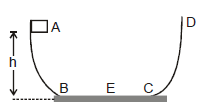
After starting from B the particle will reach C and then will rise up till the remaining KE at C is converted into potential energy. It will then again descend and at C will have the same value as it had when ascending, but now it will move from C to B. The same will be repeated and finally the particle will come to rest at E such that
BC + CB + BE = 7.5
or 3 + 3 + BE = 7.5
i.e., BE = 1.5
So, the particle comes to rest at the centre of the flat part.
Ex.20 A 0.5 kg block slides from the point A on a horizontal track with an initial speed 3 m/s towards a weightless horizontal spring of length 1 m and force constant 2 N/m. The part AB of the track is frictionless and the part BC has the coefficient of static and kinetic friction as 0.22 and 0.20 respectively. If the distance AB and BD are 2 m and 2.14 m respectively, find the total distance through which the block moves before it comes to rest completely. [g = 10 m/s2]
Sol. As the track AB is frictionless, the block moves this distance without loss in its initial
KE = =
× 0.5 × 32 = 2.25 J. In the path BD as friction is present, so work done against friction
= mk mgs = 0.2 × 0.5 × 10 × 2.14 = 2.14 J

So, at D the KE of the block is = 2.25 - 2.14 = 0.11 J.
Now, if the spring is compressed by x
0.11 = × k × x2+ mk mgx
i.e., 0.11 = × 2 × x2 0.2 × 0.5 × 10x
or x2 + x - 0.11 = 0
which on solving gives positive value of x = 0.1 m
After moving the distance x = 0.1 m the block comes to rest. Now the compressed spring exerts a force :
F = kx = 2 × 0.1 = 0.2 N
on the block while limiting frictional force between block and track is fL = ms mg = 0.22 × 0.5 × 10 = 1.1 N.
Since, F < fL. The block will not move back. So, the total distance moved by block
= AB + BD + 0.1
= 2 + 2.14 + 0.1
= 4.24 m
(E) Important Examples :
Ex.21 A smooth sphere of radius R is made to translate in a straight line with a constant acceleration a. A particle kept on the top of the sphere is released from there at zero velocity with respect to the sphere. Find the speed of the paritcle with respect to the sphere as a function of the angle q it slides.
Sol. We solve the above problem with respect to the sphere. So apply a pseudo force on the particle
Now from work energy theorem.
work done by ma = change in mechanical energy
⇒ ma R sinθ = (kf + uf) - (ki + ui)
maR sinθ = ⇒
= maR sinθ + mgR (1 - cosθ)
⇒ v2 = 2R(a sinθ + g - g cosθ) ⇒ v = [2R (a sinθ + g - g cosθ)]1/2 m/sec
Ex.22 In the arrangement shown in figure mA = 4.0 kg and mB = 4.0 kg. The system is released from rest and block B is found to have a speed 0.3 m/s after it has descended through a distance of 1m. Find the coefficient of friction between the block and the table.
Neglect friction elsewhere. (Take g = 10 m/s2)
Sol. From constraint relations, we can see that
vA = 2 vB
Therefore, vA = 2(0.3) = 0.6 m/s
as vB = 0.3 m/s (given)
Applying Wnc = DU + DK
we get - m mA g SA = - mB g SB + mAvA2 +
mBvB2
Here, SA = 2SB = 2m as SB = 1 m (given)
- m(4.0) (10) (2) = - (1) (10) (1) + (4) (0.6)2 +
(1) (0.3)2
or - 80 m = - 10 + 0.72 + 0.045 or 80m = 9.235 or m = 0.115 Ans.
Vertical Circular Motion
To understand this consider the motion of a small body (say stone) tied to a string and whirled in a vertical circle.
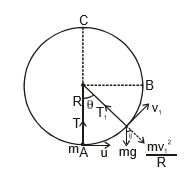
Now we study the circular motion of the body in two parts.
A) Motion of a body from A to B.
B) Motion of a body from B to C.
A. Motion of a body from A to B.

During the motion of the body from A to B.
q will increase so cosθ will decrease.
Due to which mg cosθ will decrease. From A to B speed of the body also decreases due to which decreases. Therefore tenstion in the string decreases from A to B.
But due to mg cosθ tension can never be zero.
B. Motion of a body from B to C.
from B → C
speed decreases due to which decreases.
9 decreases due to which mg cos 9 increases. Therefore from B → C. Tension in the string decreases.
String slacks at a point where = mg cos θ i.e.,T = 0
13.1 Minimum velocity at point A for which body can complete the vertical circle
The condition for the body to complete the vertical circle is that the string should be taut all the time i.e. the tension is greater than zero.
So the body can complete the vertical circle if the tension is not zero in between the region B to C.
Initially.
Apply energy conservation from A to C then
body can complete vertical circle, when
Put the value from (3) to (2) and
It the velocity is greater than equal to  then the body will complete the vertical circle.
then the body will complete the vertical circle.
Tension at A

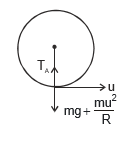
Tension at B
energy conservation from A to B
13.2 Condition for the body to reach B :
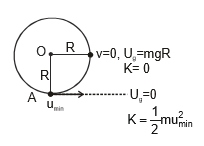
Let us calculate the umin such that the body just reaches B.
Work done by tension = 0
Only gravitational force is working on the body which is a conservative force. Therefore Applying conservation of energy, we get
then the body will oscillate about A.
13.3 When 
If the velocity of projection is greater than  but less than
but less than  , the particle rises above the horizontal diameter and the tension vanishes before reaching the highest point.
, the particle rises above the horizontal diameter and the tension vanishes before reaching the highest point.
We have seen that the tension in the string at the highest point is lower than the tension at the lowest point.
At the point D, the string OD makes an angle f with the vertical. The radial component of the weight is mg cos f towards the centre O.
.......(i)
Kinetic energy at
Potential energy at D = mg(AN)
= mg (AO + ON) ⇒ mg(R + R cosφ) = mg(R + R cosφ)
From conservation of energy
Substituting in equation (i),
This equation shows that the tension becomes zero, if
If the tension is not to become zero.
Equation (ii) gives the values of $ at which the string becomes slack.
It is the angle from the vertical at which tension in the string vanishes to zero. And after that its motion is projectile.
13.4 Tension in the string versus q
We may find an expression for the tension in the string when it makes an angle q with the vertical. At C, the weight of the body acts vertically downwards, and the tension in the string is towards the centre O.
The weight mg is resolved radially and tangentially.
The radial component is mg cosθ and the tangential component is mg sinθ.

T - mg cos , where v is the velocity at C,
......(i)
The velocity v can be expressed in terms of velocity u at A.
The total energy at
The kinetic energy at
The potential energy at C = mg (AM)
= mg (AO - MO)
= mg (R - R cosθ)
= mgR (1 - cos θ)

The total energy at
∴ From conservation of energy
u2 - v2 + 2gR (1 - cos θ) or v2 = u2 - 2gR(l - cos θ)
Substituting in equation (v),
This expression gives the value of the tension in the string in terms of the velocity at the lowest point and the angle θ. Equation (i) shows that tension in the string decreases as & increases, since the term 'g cos θ' decreases as θ increases.
⇒ T = 3mg (1 + cos θ)
Now θ = 0 ⇒ cos θ = 1 ⇒ TA = 6 mg
if, θ = 90° ⇒ TB = 3 mg
θ = 180°, cos θ = - 1
Tc = 0
13.5 Different situations:
(A) A BODY MOVING INSIDE A HOLLOW TUBE OR SPHERE
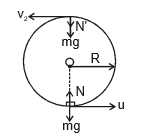
The previous discussion holds good for this case, but instead of tension in the string we have the normal reaction of the surface. If N is the normal reaction at the lowest point, then the condition for the body to complete the circle holds for this case also. All other equations (can be) similarly obtained by replacing tension T by normal reaction N.
for the body to complete the circle holds for this case also. All other equations (can be) similarly obtained by replacing tension T by normal reaction N.
(B) When Body is attached to a rod of length R
In this case since the body is attached to a rigid rod. The body can not leave the circular path.
Therefore, if the speed of the body becomes zero before the highest point C. It's motion will be oscillatory about the centre of the rod.
Condition for completing the circle:
If the body just reaches the highest point then it will completes the vertical circle
Applying energy conservation between the lowest and highest point of circle, we get
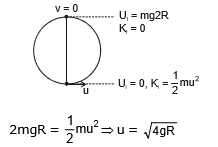
So, If the velocity at point A is greater than equal to then body will compete the vertical circle.
(C) Vertical Motion in a Dual Ring

This system will behave as the preivious system. So umin to complete vertical circle
Angle at which the normal reaction on the body will change its direction from inward to outward the ring is given by
(D) BODY MOVING ON A SPHERICAL SURFACE
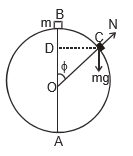
The small body of mass m is placed on the top of a smooth sphere of radius R and the body slides down the surface.
At any instant, i.e., at point C the forces are the normal reaction N and the weight mg. The radial component of the weight is mgcos f acting towards the centre. The centripetal force is

The body flies off'the surface at the point where N becomes zero.
To find v, we use conservation of energy
From equation (ii) and (iii) we get
This gives the angle at which the body goes of the surface. The height from the ground of that point AD = R(1 + cos φ)
|
169 videos|137 docs|75 tests
|























